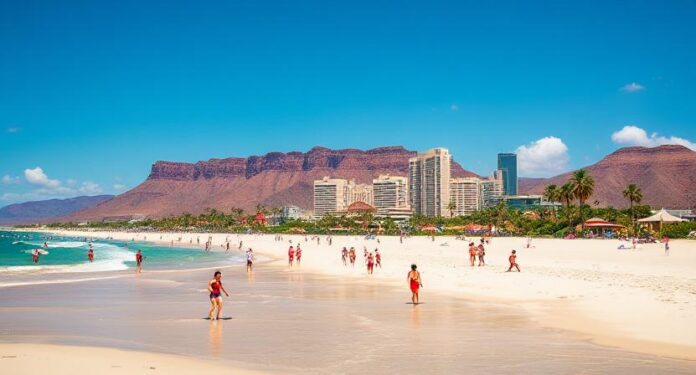Record Growth in US Tourism: A 2025 Overview
The United States is basking in a tourism renaissance in 2025, with Florida, Nevada, and Hawaii emerging as the standout destinations. As travelers yearn for unforgettable experiences, the tourism landscape in the U.S. is not only bouncing back from pandemic-induced slumps but is, in fact, thriving beyond pre-pandemic expectations. This article delves into the driving forces behind this impressive resurgence and the impact it has on the broader travel industry.
Florida: The Sunshine State Shining Bright
Florida has outpaced its 2019 tourism benchmarks, cementing its reputation as a premier travel destination. The state’s allure lies in its unbeatable combination of enjoyable weather, world-renowned attractions, and a vast array of family-friendly activities. Orlando, with its iconic theme parks, Miami’s vibrant nightlife, and the tranquil Florida Keys have become hotspots for both domestic and international tourists alike.
Key Factors Behind Florida’s Success
- Strategic Marketing Campaigns: The state’s tourism board has deployed innovative campaigns to attract visitors.
- Expanded Flight Availability: Enhanced connectivity through additional flight routes increases accessibility for travelers.
- Robust Hospitality Sector: Hotels and resorts have ramped up their services to cater to an increasing influx of tourists, ensuring a high-quality experience.
These efforts are setting the stage for prolonged success, making Florida a beacon for tourism in America.
Nevada: The Entertainment Capital
Nevada, particularly Las Vegas, showcases a dazzling array of experiences that are driving tourism growth. In 2025, the state witnessed a staggering 23 percent year-over-year increase in international visitors, coupled with a remarkable rise in visitor spending.
Unlocking Nevada’s Tourism Boom
- High-Profile Entertainment: Las Vegas is thriving thanks to a lineup of renowned entertainment residencies and major sporting events.
- Expanding Convention Calendar: The city has solidified its status as a prime hub for conventions, attracting business and leisure travelers.
- Natural Beauty: Lake Tahoe offers a contrasting outdoor experience, appealing to visitors wanting adventure alongside luxury.
Market analysts identify this trend as “revenge travel,” where people prioritize unique, high-value experiences after years of travel restrictions.
Hawaii: A Tropical Paradise on the Rise
Hawaii’s tourism rebound has surpassed expectations, with an 18.5 percent increase in international arrivals. The state’s unique offerings attract travelers despite its geographic isolation.
The Appeal of Hawaii
- Cultural Tourism: Hawaii is a magnet for travelers looking for immersive cultural experiences.
- Sustainable Outdoor Recreation: Outdoor activities that respect the environment are in demand, drawing sustainability-minded tourists.
- Extended Stays: Visitors are opting for longer trips that emphasize relaxation and exploration, catering to those who wish to truly soak in the island vibes.
Despite the surge, Hawaii is committed to preserving its natural beauty and cultural sites, employing visitor caps in sensitive ecological areas.
Trends Shaping the Travel Landscape
Several trends have emerged, steering the positive momentum in U.S. tourism:
- Domestic Travel Resilience: Americans are exploring nearby destinations that combine leisure with convenience, boosted by increased airline capacity and hotel development.
- Experience-Led Tourism: There’s a growing trend wherein travelers prioritize unique culinary experiences, outdoor sports, and cultural immersion over traditional sightseeing.
This shift toward a more experiential focus reflects changing consumer preferences and lays the groundwork for a new kind of tourism.
Navigating Challenges Amidst Growth
While the booming tourism sector offers many opportunities, it also presents challenges. Issues such as over-tourism, environmental strain, and infrastructure pressures require vigilant management.
- Over-Tourism: As visitor numbers swell, there is a risk of environmental degradation, particularly in heavily trafficked areas.
- Infrastructure Strain: Popular destinations are working to upgrade transportation systems and expand hospitality services to accommodate increasing numbers.
In light of these challenges, Florida and Nevada are investing in improvements, while Hawaii continues to enforce strict policies to safeguard its heritage.
Industry Implications and Future Prospects
The implications for the travel industry are profound. Tourism boards are ramping up marketing budgets in anticipation of continued demand into 2026. Airlines and hotel operators are expanding their services to meet growing expectations.
Additionally, the rise of long-stay travelers and digital nomads presents new opportunities. States are promoting flexible accommodations, co-working resorts, and incentives aimed at attracting extended visits, showcasing the evolving nature of travel in the U.S.
By leading with memorable experiences, sustainable practices, and enhanced accessibility, Florida, Nevada, and Hawaii are not just recovering; they are transforming the American tourism landscape, marking 2025 as a watershed year in travel history.
